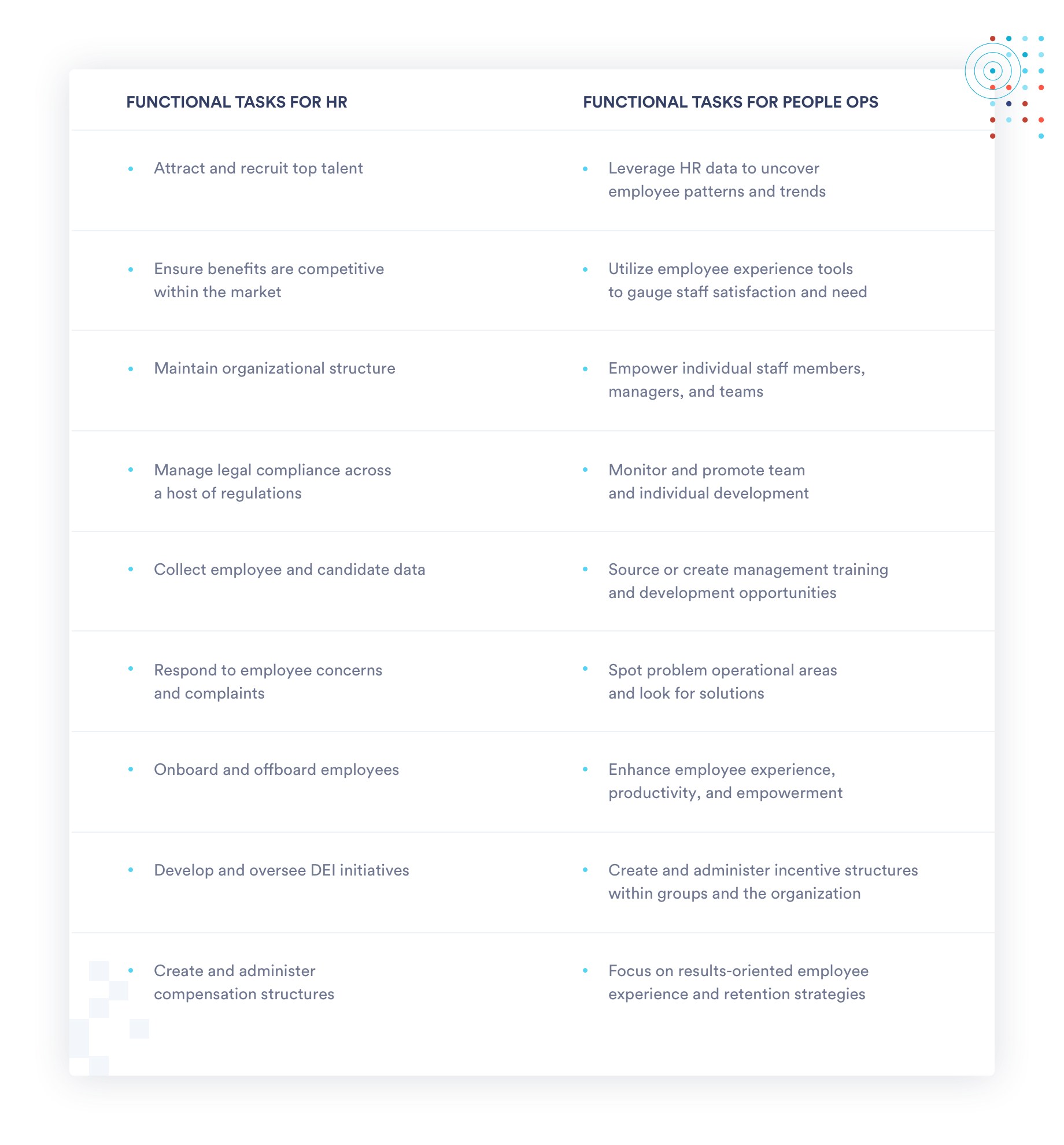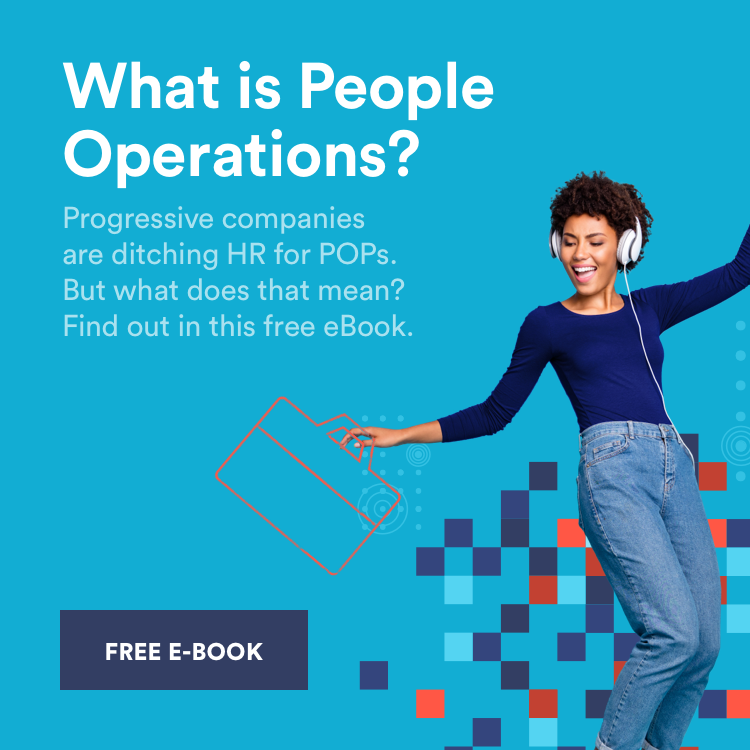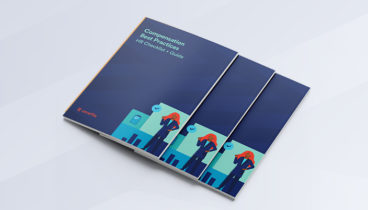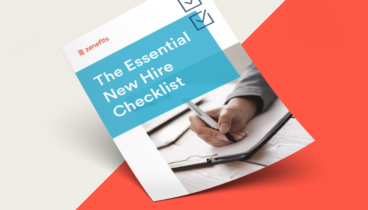Find out why People Operations focuses so much on people — and how it can impact success for your employees and entire company.

Trending in the talent management space is People Operations, or People Ops. Unlike the full HR function, People Operations focuses on the idea that people are the true customer of your business. It centers around the concept that attracting and retaining people is only part of the story: optimizing them and their employee experience is key to business success. The old saw, “happy people work harder” has been taken to the boardroom. Making sure your staff members are empowered, engaged, and results-driven are the pillars of people operations.
The difference between the standard HR function and People Operations may seem negligible: everyone on the HR team is aware of and works toward retention and engagement. But where HR has other roles to fill, People Operations are focused singularly on that task. To retain talent, you have to take care of talent; People Operations finds out how they want to be taken care of, and fills the need. It hones in on data and surveys to uncover tools, support, and services employees want to drive success at the individual level, and therefore, throughout the company.
Functional tasks for HR
Some of the major differences between HR and People Operations are basic; others are more specialized.
Here are functional tasks for HR:
- Attract and recruit top talent
- Ensure benefits are competitive, if not superior, within the market
- Maintain organizational structure — i.e., job descriptions, reporting, and succession planning
- Manage legal compliance across a host of regulations
- Collect employee and candidate data
- Respond to employee concerns and complaints
- Onboard and offboard employees
- Develop and oversee diversity, equity, and inclusion initiatives to create a welcoming and inclusive workplace
- Create and administer compensation structures to assure competitiveness
For HR professionals, legal compliance protects the business and the workforce. While regulatory compliance informs much of what they do and how they execute, it’s a small but guiding portion of HR’s contribution to the organization and its mission.
HR: hiring and retention
HR continuously assesses recruitment tools and efforts to determine the best success rates for each hiring strategy. They spot trends in recruitment and adjust accordingly, working competitively to attract the best talent available in their market.
HR continuously assesses recruitment tools and efforts to determine the best success rates for each hiring strategy. They spot trends in recruitment and adjust accordingly, working competitively to attract the best talent available in their market.
They’ve made an extraordinary shift recently to source, train, and supervise remote talent. Doing this has opened up organizations to a wider (and often more diverse) talent pool as they adjusted to changing market conditions and demands. Able to shift on a dime, they’ve moved screening, scheduling, and interviewing off-site to meet and accommodate job seekers while continuing to achieve head. These professionals are adept at quickly shifting recruitment strategy to achieve their goals.
HR: employee development
They create and administer effective onboarding that retains new hires, particularly in those first few vulnerable months. To further an environment that’s welcoming and inclusive, they create and closely monitor DEI initiatives, looking for areas where improvement is needed, results are promising, and models within the organization have been created.
HR teams analyze trends in employee advancement and learning, working independently or with People Ops teams to make recommendations for remediation strategies, development, and succession planning. Administrative tasks for HR may seem rote — like creating job descriptions and compensation packages that are equitable — but all these enhance employee experience and grow the organization.
HR: data
HR has a wealth of employee and job seeker data at its disposal. As we move more toward data-driven organizations, the role of HR may be twofold: analyzing the data for their own use for compliance and development, and sharing subsets of the data for People Operations to further their goals.
Functional tasks for People Operations
Here are functional tasks for People Operations teams:
- Leverage HR data to uncover employee patterns and trends; make adjustments and strategic plans
- Utilize employee experience tools to gauge staff satisfaction and need
- Empower individual staff members, managers, and teams
- Monitor and promote team and individual development
- Source or create management training and development opportunities
- Spot problem operational areas and look for solutions, either through resources or training
- Actively search for resources to enhance employee experience, productivity, and empowerment
- Create and administer incentive structures within groups and the organization
- Focus on results-oriented employee experience and retention strategies
People operations: data-driven tools
People Operations professionals look for resources to optimize employee experience, performance, development, and productivity. They leverage a variety of tools to find out what employees need, want, and can use. This helps staffers grow within their roles and the organization.
Analytics that show when and where employees are slowing down, working at full capacity, or middling can lead People Operations to search for solutions and tools that help. Employee surveys uncover areas of concern and need, then target resolution and development. Providing access to necessary resources and information is a focus of the People Ops pro. Whether it’s organizational data or personal development, an informed workforce is an engaged workforce.
Providing access to necessary resources and information is a focus of the People Ops pro. Whether it’s organizational data or personal development, an informed workforce is an engaged workforce.
Tools they leverage include basics, like software that allows employees to manage their own time, attendance, and PTO — underscoring the organization’s trust in employee integrity. Complex assessment tools can measure skills, personality, and ability, providing the People Operations professional guidelines on how to work with each staff member to create a career path that not only meets their professional ability and potential, but aligns with their personal values. This can boost work/life balance as well as professional and personal fulfillment.
People operations: employee experience
Just as an organization strives for the best customer experience, People Operations professionals look at the employee as a customer. They care about driving consumer-grade experience for each member of the staff. People Ops monitors emerging trends and tools — just as marketing professionals would — to find new ways to enhance employee experience. But they don’t necessarily look for the easiest solution. An example could be compensation: evaluating what method — wages, PTO, bonuses or additional benefits — would be the most impactful, rather than just recommending across-the-board increases.
People Ops professionals focus on application of all the tools currently (and emerging) at their disposal to create a top-notch workforce, optimized for personal and professional success. They strive to create an enviable employee experience that makes job seekers want to work for their organization and current employees never want to leave.
You may see People Operations increasing in popularity, but it’s hardly a new concept. In 2014, Prasad Setty, leader of Google’s people analytics group, told LinkedIn that their goal is to “bring the same level of rigor to the people-decisions that we do to engineering decisions.” Your most valuable resource is talent. Attending to their needs and optimizing them is as important as making sure your organization’s physical equipment is well cared for and maintained.








